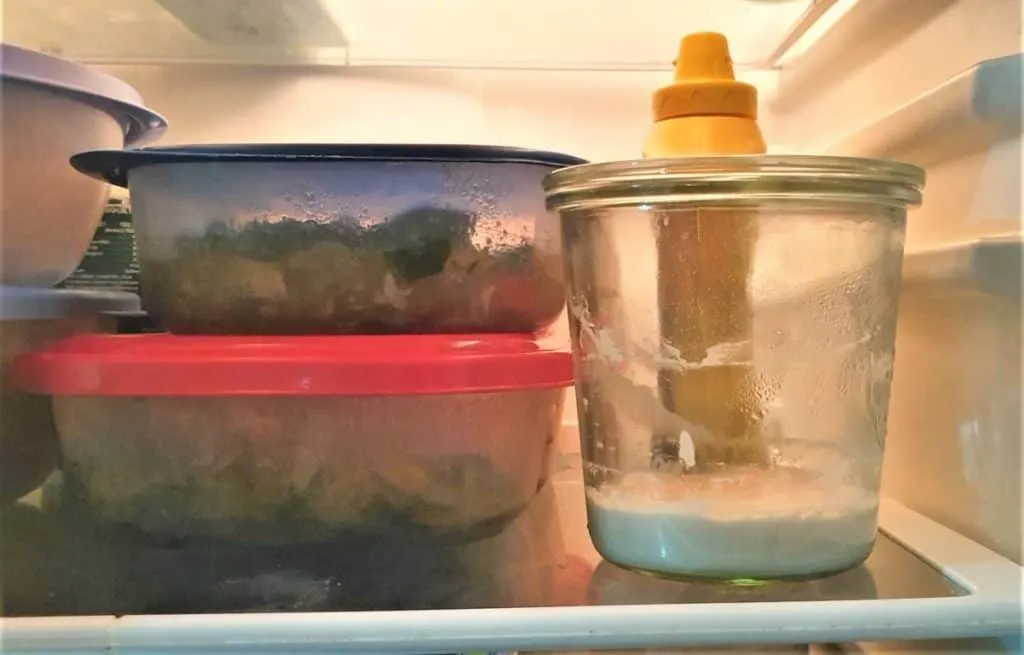
Sourdough starters are the main ingredient used to flavor sourdough bread, giving it a tangy, sour taste. A starter can be kept for several months to hundreds of years, depending on how often you will use it and how much time you have to care for it.
If the sourdough starter is not used daily, it can be kept in the refrigerator. Storing it at a cool temperature of 35-50°F (1.5-10°C) will slow down fermentation. It is easier to maintain at this temperature, as it will only need to be fed once a week minimum to stay alive.
A starter can be kept at room temperature, refrigerated, dried out, or frozen. There are different techniques that need to be followed with these different storage methods; some will require more care and maintenance compared to others. There are pros and cons to storing it in the refrigerator.
Is The Refrigerator The Best Storage Method For Your Starter?
A sourdough starter can be stored in many different ways; you can keep it in the refrigerator, freezer at room temperature, or it can be dried out. The storage method you decide on using will depend on how often you will need your starter and how often you can feed it.
It is possible to keep a sourdough starter alive and healthy for hundreds of years. If you want to do this or have one that is very old, it can be passed through the generations within your family.
It is beneficial to keep your starter alive for an extended period; this is because you won’t need to make a new one every time you want to bake. You will always have one on hand that is mature and full of flavor.
A starter may not always be needed daily, and it may be hard to care for regularly. If you cannot feed it daily, it would be best to keep it in a dormant state where fermentation will be put on pause or slowed down. This can be done through refrigeration, freezing, or drying out.
There are other ways of keeping your starter alive for longer periods between feeds. This can be done by lowering its hydration, reducing the number of whole grains it contains, keeping it at a low inoculation percentage, and increasing the salt quantity.
Let’s take a look at how to store your starter in the fridge, as well as the other ways it can be stored.
Keeping Your Starter In The Refrigerator

If you need your starter for baking only once a week, once a month or longer, it would be a great idea to store it in the fridge at an optimal temperature of 38°F (3°C). This method will make it easy to care for, and it has the quickest reactivation time when you desire it for baking.
Before placing it in the fridge, it must be fed; this is done by first removing just under half of it, which you can discard or keep to make a new starter. Feed it the amount of flour and water you usually give and keep it in an airtight container.
Once you have fed your starter, allow it to stand at room temperature for about 2 to 3 hours before putting it in the fridge. Giving it this time to rest at room temperature will rejuvenate and nourish the yeast.
Another option when feeding it to help your starter hold up better in the fridge will be to lower its hydration. You can do this by feeding it the full amount of flour you usually do and only adding 80% of the water it gets.
This storage method is handy as it won’t need as much TLC, maintenance, and feeding. Make sure you feed your starter once a week initially to keep it alive and to ensure its flavor is maintained. The younger your starter is, the more it will need to be fed until it is strong enough to survive between longer feeds.
Although this advice is mostly recommended, if you don’t feed it once a week, it will still survive. As it gets older, it can be left in the fridge for more than two weeks without being fed.
Your starter will need to be reactivated before it can be used for baking. You can do this by taking it out of the refrigerator 12 to 14 hours before baking. You must feed it as per the pre-refrigeration feeding advice above and allow it to sit at room temperature.
You will need to feed 2 to 3 times before it can be used; it will double its original size within 6 to 8 hours; if this doesn’t happen, you should feed it again.
Note: You can use your fridge not only for storing your starter but also for proofing your sourdough dough. Check out my article “Can You Refrigerate Sourdough Dough?” if you want to learn more.
Keeping Your Starter At Room Temperature
If your plan is to use your starter daily or every second day, it is best to store it at a room temperature of 70-80°F (21-26.5°C). You can place it on the kitchen counter out of direct sunlight.
Since you will need it this often, it is unnecessary to keep it in the fridge because it will take too long to reactivate each time. You will also end up using more ingredients as you will need to feed it a few times in the space of 12 hours before it can be used.
In this environment, you will need to feed it every 12 to 24 hours to keep the microbes happy. If the weather is colder than the required temperature, you can feed it once a day, and if it is hot, it is best to feed it twice a day.
If you are unable to feed it at the required times, you can make your starter’s consistency stiff. You can do this by feeding it the same amount of flour, 70% of the water, and half the amount of mature starter than you usually would use.
You can lengthen the time between feed by adding cold water to your starter when fed; this will help slow down fermentation.
You can tell if you are leaving your starter for too long between feeds if it starts forming a liquid layer on the top called a hooch. If this happens, you should feed it more frequently, and if not, it will die.
A sourdough starter that is kept at room temperature is known to have a milder flavor compared to one held in the fridge.
Keeping Your Starter In The Freezer
If you need to store your starter for many months or even a year without feeding it, it is best to stash it in the freezer. Just like a refrigerated starter, it must be fed before freezing; you should feed it double the amount of flour than usually to make it into a thick paste. It must be stored in a sealed, airtight container.
It would be best if you did not keep your starter in the freezer for longer than a year at a time without it being feeding. When you remove it from the freezer, first allow it to thaw before feeding it, you can feed it as you usually would. Feeding your starter will help reactivate the yeast and improve its strength. Check out my article “Does Freezing Harm Sourdough Starter?” if you want to learn more about freezing your sourdough starter.
Other storage methods you can consider to store your starter for an extended period without having to feed. These include drying and crumbling into flour; or spread, dry, and crack into shards.
Benefits Of Storing Your Starter In The Refrigerator

These are some of the many benefits to keeping your starter in the refrigerator:
- It is a simple and easy process.
- It doesn’t need as much attention and care; it won’t need to be cared for daily.
- It is a useful method to use if you have a hectic schedule or are going away and can’t care for it daily.
- It is fed less often; your starter only needs to be fed once a week, minimum.
- Less flour and water will be used as feedings are reduced.
- It is an excellent way to stash it if you only plan on baking once a week, once a month, or longer.
- You can ensure that your starter will b able to maintain its optimal flavor and maturity.
Negatives Of Storing Your Starter In The Refrigerator
Before deciding whether storing it in the refrigerator is the best option, it is good to consider the negative aspects of this method:
- It is not an entirely hands-off way to store your starter; it will still require attention every week to every two weeks
- You could forget about it easily; you either might not remember how long you have kept it in the fridge or when last you fed it. Labeling your jar can be helpful to remember when you stored and fed last.
- Although you have slowed down the fermentation process, it is still active. If you forget about it and neglected it for too long, it can die easily. It can take 2 to 5 months for it to die if not attended to.
Conclusion
There are many storage methods you can use for your starter; the method you decide to use will depend on how often it is needed as well as how much time you have to care for it. There are also other ways it can be stored for an extended period without being fed.
Storing a starter in the refrigerator has many benefits if cared for correctly; these include its ability to maintain its full flavor and maturity. If you can master keeping your starter alive for many years, you will one day have the opportunity to pass it down to your children or other family members.
It is essential to know how to revive your starter as this will be required every time you have to take it out of the refrigerator, freezer or if it was dried out. Before it can be used in baking, this will have to be done.
Note: If you keep your sourdough starter for a long time you might wonder if it can go bad. Find out more in my article “Does Sourdough Starter Go Bad?”

Hi, I am Aysha
I love spending time creating the most helpful content I can so that you can become a better sourdough baker.
If you’ve enjoyed what you’ve learned, consider saying “Thank you!” by leaving me a tip here. I appreciate your kindness and support 🙂
Join Us and Transform >
Don’t Be an Amateur! Master the Art of Sourdough Bread!




Aysha, your words really transported me back to my time and experiences in south-east Asia! Just as you beautifully described, the fusion of old traditions and modern merriment there is simply unmatched.👌Do you think everywhere in the world will eventually strike that balance?🌍 What are your thoughts on cultural assimilation? I believe other readers may draw inspiration from the role collective history plays in shaping our future, as outlined in this article. Massive food for thought: let’s preserve identity without undermining development. Looking forward to your perspective. 👋😊